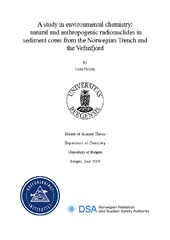| dc.description.abstract | In this work the anthropogenic radionuclide Cs-137 and the naturally occurring radionuclides Ra-226, Ra-228, Pb-210 and K-40 have been studied in sediment cores from the Norwegian Trench and from the Vefsnfjord in Nordland. Caesium-137 is a fission product, introduced to the environment by nuclear weapons tests in 1950s and -60s, discharges from reprocessing plants for spent nuclear fuel, and from accidents like the Chernobyl accident in 1986. Levels of Cs-137 in Norwegian marine areas are generally low, and the levels are routinely monitored. Investigations in selected Norwegian fjords have, however, shown elevated levels of Cs-137 in surface sediments and sediment profiles, compared to adjacent open marine areas. The Vefsnfjord, which is investigated in this work, is one of the fjords in Norway with the highest measured levels of Cs-137. The contamination source is most likely the Chernobyl accident. Potassium-40 is a naturally occurring radioactive isotope of potassium (isotopic abundance of 0.012%). Radium-226 and lead-210 are members of the natural radioactive “uranium series”, while radium-228 is member of the natural radioactive “thorium series”. All four are found in various amounts in bedrock and the marine environment. However, it is well known that different industries, including the oil and gas industry, also discharge naturally occurring radionuclides to the marine environment. In this thesis, local and regional variations of Cs-137, Ra-226, Ra-228, Pb-210 and K-40 in the two study areas have been investigated. Such information is important when monitoring results are to be interpreted, as monitoring results often are thought to represent a large area. Results from analyses of the different radionuclides in sediment cores taken within an area of 30x30 cm were generally in good agreement with regards to activity concentration, both in the Norwegian Trench and in the Vefsnfjord. Some regional variations between the different sampling locations in the Vefsnfjord were, however, found. The Cs-137 in the Norwegian Trench ranged from below the detection limit (<0.4) to 3.0 Bq/kg dry weight, while the levels found in the Vefsnfjord were in the range of 13 to 432 Bq/kg dry weight. The levels found in the Vefsnfjord show that still over 30 years after the Chernobyl accident, elevated levels of Cs-137 are found in sediments in the fjord. Levels of the other radionuclides studied in this work are comparable for the two study areas. Radium levels in sediment cores from the Norwegian Trench and the Vefnfjord ranged from 23 to 53 Bq/ kg d.w. and from 28 to 79 Bq/kg d.w. for Ra-226 and Ra-228, respectively. Pb-210 levels ranged from 24 to 279 Bq/kg d.w., and K-40 levels ranged from 581 to 949 Bq/kg d.w. The radionuclide levels found in the present study are generally in good agreement with results on radionuclide levels in adjacent areas. There are, however, few studies on radioactivity levels in the Vefsnfjord, and generally few studies on naturally occurring radionuclides in sediments to compare with. Also, often only surface samples have been analyzed, and thus comparison with sediment profiles could not be done. All sediment cores were dated using the CRS Pb-210 dating method, and sedimentation rates were determined using both Pb-210 and Cs-137. The sedimentation rates found in the Norwegian Trench ranged from 0.07 to 0.12 cm/year, and the sedimentation rates from the Vefsnfjord ranged from 0.17 to 0.27 cm/year. The results are in fairly good agreement with results found in the literature. Four cores from the Vefsnfjord were analysed for total organic carbon (TOC), total carbon (TC), and total sulphur (TS) (LECO analyses) at the Norwegian Geological Surveys (NGU). The content of TS ranged from 0.10 to 0.49 %, the content of TC ranged from 1.4 to 2.9 %, and the TOC content ranged from 1.0 to 2.0 %. | en_US |
